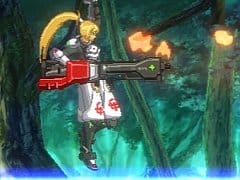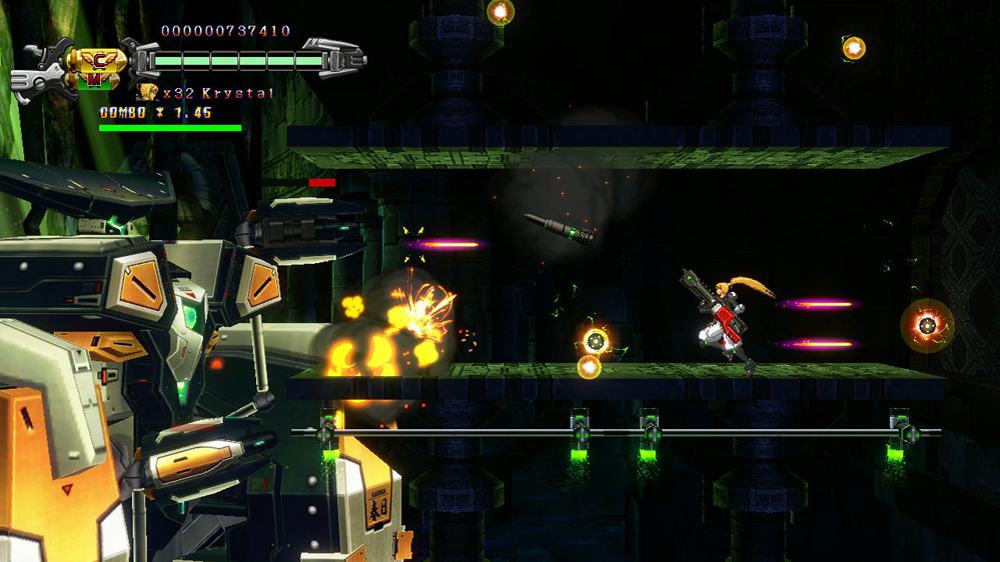You can trust VideoGamer. Our team of gaming experts spend hours testing and reviewing the latest games, to ensure you're reading the most comprehensive guide possible. Rest assured, all imagery and advice is unique and original. Check out how we test and review games here
I generally consider myself to be pretty decent at games. Not particularly amazing, but adequate, and I prefer my games erring on the side of too hard rather than too easy. Getting 100 per cent completion on Bayonetta was a personal gaming highlight of 2010, for instance. Because of this I deemed myself the perfect person in the office to tackle Hard Corps: Uprising.
Maybe I was wrong.
Hard Corps: Uprising is exhausting – and not in a good way. Time spent chipping away (often fruitlessly) at its eight stages is rarely satisfying, and an initial rush of retro-tinged goodwill is quickly eroded when you’re sent crashing back time and time again to a dishearteningly faraway checkpoint. While I can sympathise with – and inherently encourage – developer Arc System Works’ desire to make Uprising a challenging game, there are far too many wonky encounters and frustrating moments along the way. The robot spider at the end of level six, which you have to fight without falling to your death dozens of times, is one of the least enjoyable bosses I’ve fought in years.
For those who fancy a bit of a history lesson, Hard Corps: Uprising is a semi-prequel to 1994’s Contra: Hard Corps, the side-scrolling shooter which Europeans may (but probably won’t) know as Probotector, which itself is one of many sequels to 1987 heavy-hitter Contra, a game so difficult it was responsible for popularising the most famous cheat code of all time.
Up, Up, Down, Down, Left, Right, Left, Right, B, A and Start do nothing here, however. I’ve already checked. This is 2011, after all, and Konami will just sell packs of 30 lives as premium DLC.
Arc System Works has stamped its own visual identity on the series, with the 2D character sprites immediately recognisable to those familiar with Guilty Gear and, more recently, BlazBlue. Occasional efforts to feature 3D models (such as bosses) on a mostly 2D screen usually look slightly squiffy, but the game keeps its aesthetic fairly clean and pleasing for the most part.
Despite the bizarre decision to lop Contra off the title, the nitty-gritty is much the same as always; you start on the left of the screen and move to the right, blasting everything which stands in your way. For your significant time investment, at least if you’re looking to complete the game’s three-strikes-and-you’re-out arcade mode, you get eight levels, two characters and one guffy plot revolving around the future space military and oppression or something – it’s all told with sparse amounts of terrible voice acting and thick blocks of chunky text during load screens, but you’ll probably be off looking at your friends’ Achievement lists at this point. But never fear, as the guns are still the stars of the show, with many of Contra’s reliable favourites, like the Spread Shot, making their return.
Ah, the Spread Shot – I have missed you. You truly are an iconic weapon of the 80s, with your screen-filling streams of fiery red bullets putting you on a similar level of overpowered mayhem as Modern Warfare 2’s akimbo 1887s. But not quite.
Weapons, two of which can be carried at once, drop like candy out of floating green piñatas whizzing across the screen at set points, and these let you beef up your standard pew pew assault rifle into altogether more resplendent options – lasers, bombs and plasma charges, for instance. Each weapon can be upgraded twice more by picking up another of its type, meaning you’ll need to be careful not to pick up a Ripple Gun when you’ve got a level 3 Spread Shot.
It’s also imperative you avoid enemy fire, as taking a bullet means you’ll lose any equipped weapons and a slab of health – there’s three bars for the male character and two for the female, proving that gender inequalities are absolutely fine if you frame your game around a nineties vibe. As a general rule of thumb, regardless of which character you pick, if you stick with the Super Machine Gun and Spread Shot you’ll be perfectly equipped for every instance.
New additions include a combo meter and the ability to sprint, air dash and reflect bullets. But the game has no sympathy for you, and doesn’t even bother attempting to teach you how these things actually work. They’re there if you want them, basically, though I do get a slightly perverse satisfaction from watching my high score tick upwards while batting enemy sniper rounds across the screen.
Seeing as an Arcade run is designed to be impenetrable, most will likely play the game via the more flexible and considerate Rising mode, which lets you pick your starting level and spend in-game credits to upgrade your character beyond stock settings. Uprising’s economy is fierce, however, and by the time I got to the last level I’d barely been able to afford more than upgrading my lives stack to nine and elongating my life bar a few notches. Decking your character out with the full arsenal of upgrades, and thus unlocking abilities like triple jumping, will be a pipe dream to all but the most committed players.
Few will opt to go down that path, however, as Uprising doesn’t capture its audience like Contra: Hard Corps did in 1994. Uprising pares the franchise down to its component parts, but like a child messing with their father’s antique watch it’s got absolutely no idea how to put it back together again.
Even worse, the game’s eight stages are each about three times too long, dragging you through endless screens of enemies and two or three sub and main bosses before letting you take a breather; the game generally outstays its welcome even more than a games journalist at an open bar. The problem becomes even more pronounced as Uprising progresses into its later stages, with levels developing an inexcusable fondness for cheap, annoying, and unfair death traps.
What Arc System Works seems to have forgotten is that there’s a fine line between challenging and unfair. Bayonetta is challenging. Demon’s Souls is challenging. Uprising’s off-screen enemies, which cause you to plummet to your death by attacking as you jump over chasms, are simply unfair. Platforming gimmicks are introduced in every single level to rub salt into the wound, probably in a failed attempt to spice up the level design, further diluting the fundamental experience of shooting guns and dodging bullets to a pitifully thin constitution.
The opening level puts you in a desert, complete with the requisite amount of cracked ground, crisp blue sky, and quicksand populated by evil robot worm, and the vintage mise-en-scène is completed with you fighting bread-and-butter foes against the backdrop of a crashed spacecraft. It’s probably the most creative bit of design in the game, with any residual charm from this moment truly dead and buried by the time you’re skulking through a factory with a supposed focus on stealth that I never quite managed to work out – Contra or no Contra, I have an itchy trigger finger and I’m not afraid to use it. It’s all a bit tedious at this point, but you’ll think there’s a chance it could pick up in time for an explosive finale.
Go a couple of levels further, however, and you’ll be shouting words at the screen that I’d never be allowed to write in public, such as the Naughtie one BBC presenters have all been saying a lot recently.
Maybe you’ll be devoted and talented enough to see the game to its conclusion. As for me, I’m out. I got to the third form of the final boss and decided I’ve had enough – in this instance, at least, I’m not nearly interested enough to take that exhausting last step to the end credits. If Konami is genuinely sincere in its desire to stage an uprising, they’ll certainly need to try a bit harder next time.
Hard Corps: Uprising
- Platform(s): PlayStation 3, Xbox 360
- Genre(s): Action, Arcade, Platformer, Shooter







